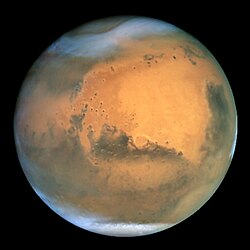Sol (tidsenhet)
Sol har utvecklats till en tidsenhet, som löst introducerades av NASA år 2004 att utgöra ett dygn på planeten Mars.[1]
1 sol skulle alltså motsvara 24 timmar, 39 minuter och 35,244 sekunder.
Tidpunkten för Opportunity:s landning, den 25 januari 2004 05:05 UTC angivet i jordens tidssystem, kallar Nasa sol 1. Systerfarkosten Spirit, som landade cirka 3 veckor tidigare den 3 januari 2004, kan på samma sätt sägas ha landat 20,5 sol före sol 1.
Beteckningen kan synas olyckligt vald, med tanke på vad man i så fall ska välja för måttenhet för tid på övriga ännu inte namngivna roterande kroppars tid i solsystemet.
Referenser
- ^ NASA Technical Notes on Mars Solar Time as Adopted by the Mars24 Sunclock - "and is customarily referred to as a "sol" in order to distinguish this from the roughly 3 % shorter solar day on Earth"
| ||||||||||||||||||||||||||||||||||||||||||||||||||||||||
Media som används på denna webbplats
NASA's Hubble Space Telescope took the picture of Mars on June 26, 2001, when Mars was approximately 68 million kilometers (43 million miles) from Earth — the closest Mars has ever been to Earth since 1988. Hubble can see details as small as 16 kilometers (10 miles) across. The colors have been carefully balanced to give a realistic view of Mars' hues as they might appear through a telescope. Especially striking is the large amount of seasonal dust storm activity seen in this image. One large storm system is churning high above the northern polar cap (top of image), and a smaller dust storm cloud can be seen nearby. Another large dust storm is spilling out of the giant Hellas impact basin in the Southern Hemisphere (lower right).

